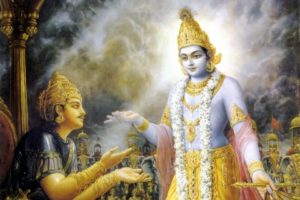Gita means a recital; a song. This Gita once uttered was later transformed into the speech of the ‘holy’, but although the importance of the ‘holy’ remains as in close contact with the Hindutva, the remains of the Gita found are very few. The Gita of our speeches, collide with the Gita of the society, giving away a new definition of the ‘holy’ as seen now. What exactly is the reality of Gita?
The essence of the Gita begins from the Kurukshetra Bhoomi where Krishna recites the Gita to his friend Arjuna. Also, as we know the whole Gita is recited to Arjuna in a matter of a second when the whole universe except Krishna and Arjuna becomes still. It is a moment of realisation to attain moksha through one’s dharma. This realisation of one’s own purpose in life is the birth of karma and at the same time, meeting one’s end after meeting the end. These constant births and deaths, is the Gita of the life as a cycle.
Karmanye Vaadikaaraste
Maa phaleshu Kadachana
Karmaphala Hethurthurma
Thesangosthwa Karmani
A much-repeated verse from the Gita, that teaches us to perform our duties sincerely and never expect the results. But who lives the next second without doing preparations for it during the previous one? These perplexing statements of the Gita tangle the mind even more by asking its readers to get rid of any desires as desires are the root cause of the destruction of one’s soul. This might be a very hard phrase to live on in this consumerist world. The desires of one’s self is to be diverted to one’s own self. It must be an enhancement of the soul to know the truth. The definition of education by Swami Vivekananda which goes, “Education is the manifestation of the soul”, then is an inversion of desires to know the true self.
On one side are the Kauravas with Dhuryodhan as the next heir to the throne of Hastinapura. He fights the Pandavas with the main warrior Arjuna. The Gita also portrays a strong bond between Krishna and Arjuna, when Dhuryodhana on the other side has a true friend in Karna. Arjun here is a character who loses confidence but has it all inside. Krishna takes it out through his song, the Gita.

Krishna and Arjuna may portray two friends, a teacher and a student, perhaps a ‘you and I’ as displayed as the titles of Devdutt’s Pattanaik’s book ‘The Gita’. You and I here is a conversation between the mind, body and the soul, where in the mind and the body constitute the image of the character Arjuna and soul; Krishna. When Krishna displays his ‘Viswaroopa’ to Arjuna, the latter is pleased enough to digest the song of the former. This ‘roopa’ or the form with a thousand eyes, with all the deities and the panchtatva or the five elements of nature, represented the universe in itself. The cycle of karma or the life-death cycle being the main essence of the form perhaps drives the readers to the existential angst. But a close study of the ‘roopa’ may conclude the message of the Prakriti – Purusha union. This union of nature and the man’s interdependence, living in harmony. Nature versus nurture, a concept rising here. This as defined by Krishna is the ‘dharma’ of a human on earth. Now dharma has different connotations as to whether it is actually the ‘justice’ or the ‘duty’. In any instances of the Mahabharata, this overturning of the justice and the duty are seen resulting in the questioning of what is morality.

Gita, still remains as the ‘holy’ Hindu book. The titling of the ‘holy’ to the Gita could be in a spiritual way which is mostly turned into a religious way. But happily, in the case of Gita, the religious aspect is considerably less. This song is much in need in this scenario of consumerism and modernism. A song which reminds us somewhere of our own selves and its needs pertaining to one’s nurture of the self and nature. Hence, the Gita helps us in deciphering the knowledge of the true self which in the least is carried forward by the so-called readers of the ‘holy’ Gita. The ‘holy’ in the Gita should thus be transferred more into the reality and truth of the self in this scenario of a relay.


Awesome! Its in fact amazing paragraph, I have got much clear idea regarding from this piece of
With thanks! Valuable information!
With thanks! Valuable information!
Don’t wear seat belts lest you drown in you own urine?
I got what you mean,saved to fav, very decent site. http://bambam365.com/
good stuff. I will make sure to bookmark your blog. https://php665.com/